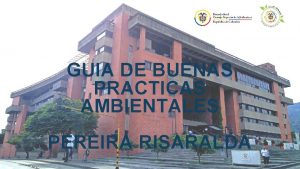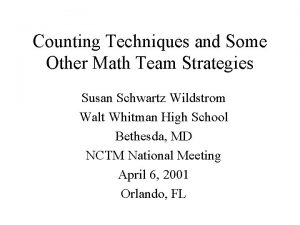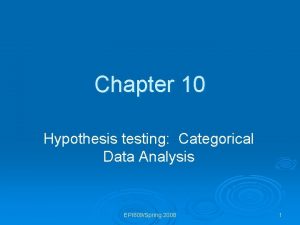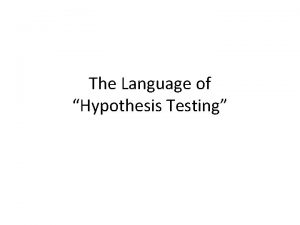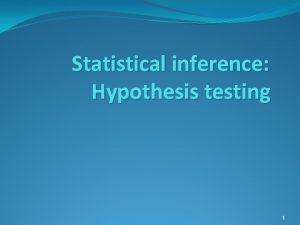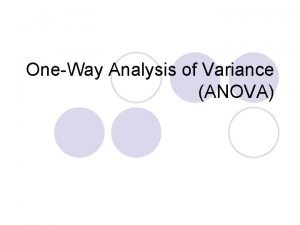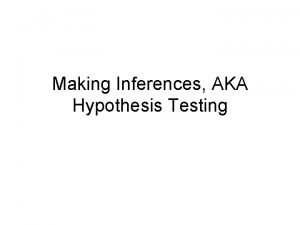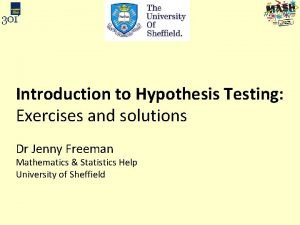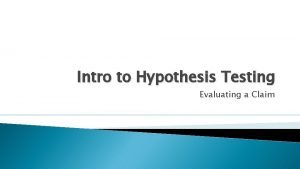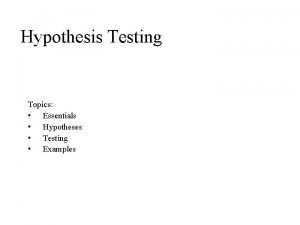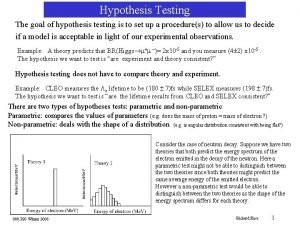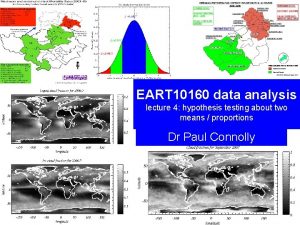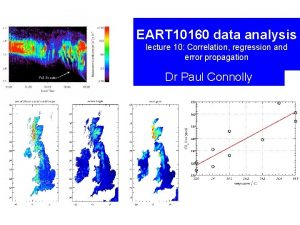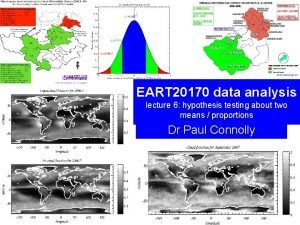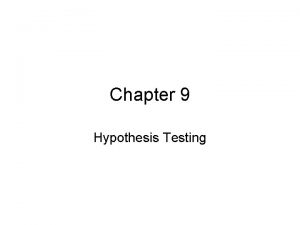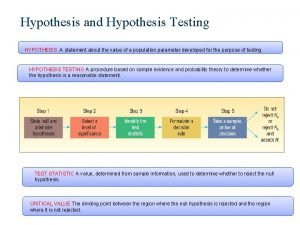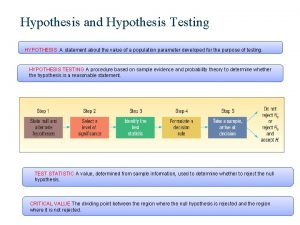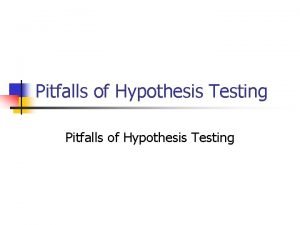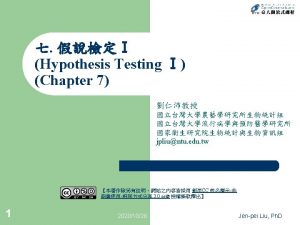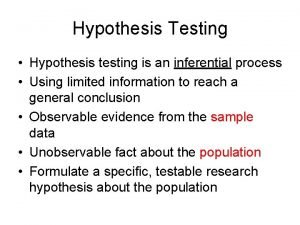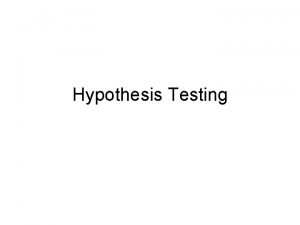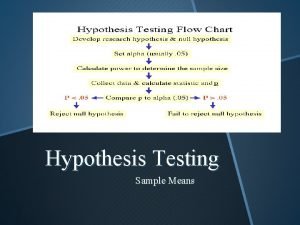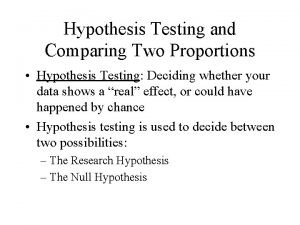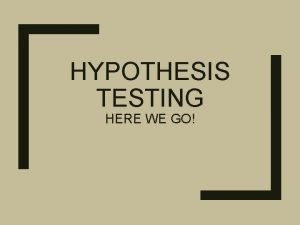EART 10160 data analysis lecture 3 hypothesis testing


























- Slides: 26

EART 10160 data analysis lecture 3: hypothesis testing about a proportion or a mean Dr Paul Connolly

Intended learning outcomes • Know how to formulate and test a hypothesis about a population mean from sample data • Have an appreciation why it works! • There are many examples, a few could be…

Examples of hypotheses to be tested • Is the ratio of male: female students 50: 50? • Is the gold content in a seam above 5 ppm? • Do atmospheric aerosol particles increase or decrease the chances of rain? • Does it rain more at the weekend than during the week?

Definition • Hypothesis: A testable statement on the basis of limited evidence as a starting point for further investigation. • Null hypothesis: A type of hypothesis used in statistics that proposes that no statistical significance exists in a set of given observations. • Alternate hypothesis: the opposite to the null hypothesis

All hypothesis tests in this course: • State the null and alternate hypotheses: – E. g. H 0: m=0, H 1: m>0 – Or, H 0: p=0. 5, H 1: p≠ 0. 5 – Or, H 0: r=0, H 1: r≠ 0 • Calculate a statistic (to be defined): something that if null hypothesis is true is distributed according to a theoretical distribution. • Calculate a critical value from theoretical distribution. • Assess which is largest: statistic or critical value and • Accept the null if statistic < critical value or reject the null (and hence accept the alternate) if statistic > critical value. • You can also calculate a p-value for the hypothesis test which is the probability to the left of the calculated statistic (e. g. the pvalue is 0. 0001). • I’ve noticed that many journals in the biological sciences do quote p-values for their tests. It is useful because it allows the reader to assign their own significance level and make their own judgement.

What statistics shall we calculate from our data? I • Statisticians have found that if you take a random sample, size N, from a population of which a proportion p answer `yes’ to a question and ask that sample the same question, the statistic: p=population proportion saying either yes or no (depends on convention). q=population proportion saying the opposite to p p =sample proportion saying either yes or no z will be: • Distributed according to a standard normal distribution (if the data are drawn from the same population). • Therefore, if we calculate a value of z from our data that is large, we can say it is unusual.

Confidence levels and significance levels • Usually we want to be confident that the statement we make is correct. Unfortunately you can never be 100% confident in anything. 10% chance that the value is in this region 5% in each `tail’. Select a value at random, We call this a 10% significance level 90% chance within these bounds. Thus 90% confidence level Critical value is the point where the x-axis goes into the red region • Therefore significance level, a=1 -confidence level

Example: proportions What is the p-value? normcdf(-1. 79, 0, 1)=0. 037

Coventry

Kirklees Is the average mortality rate statistically different to the UK average 5. 33 in 1000 (for the same period)? http: //en. wikipedia. org/wiki/List_of_countries_by_infant_mortality_rate#UN_United_Kingdom

What statistics shall we calculate from our data? II • Statisticians have found that if you take a random sample, size N, from a population with mean, m, and calculate: • z will be: – Distributed according to a normal distribution • t will be – Distributed according to a Student-t distribution (because the sample standard deviation is usually lower than the population; hence, t will usually be larger than z) • Therefore, if we calculate a value that has a large value of z or t, we can say it is unusual.

Student’s t-distribution • Used when you don’t know population standard deviation. Nearly always! Note the t-distribution is a bit broader than the normal distribution because the sample standard deviation usually underestimates the population standard deviation, so t tends to be bigger than z Symmetrical, tends towards normal distribution for high n, but broader at low n

To calculate these using computer • MATLABer’s rejoice! tinv is used the same way as norminv. • Exceller’s: oh dear, by default tinv gives you the t -value for the two-tailed probability, so if you multiply P by two it gives one tailed.

Excel vs Matlab sampling distributions • To calculate the distance from the mean for the normal distribution: – norminv(P, m, s) – NORMINV(P, m, s) [ Matlab] [ Excel ] • To calculate the cumulative probability for a distance from the mean for the normal distribution: – normcdf(z, m, s) [ Matlab ] – NORMDIST(z, m, s, 1) [Excel ] • To calculate the distance from the mean for the t-distribution – tinv(P, n) – TINV(2 x. P, n) [ Matlab ] [ Excel ] • To calculate the cumulative probability for a distance from 0 for the t-distribution – tcdf(t, n) – TDIST(t, n, 1) [ Matlab ] [ Excel ] • Note that Excel doesn’t have negative values of t either!

Gold seam at Matilda, Australia (April 2012) http: //www. resourcesroadhouse. com. au/_blog/Resources_Roadhouse/post/Blackham_fires_up_new_drilling_program_at_Matilda/

Gold seam at Matilda, Australia (April 2012) • Mining company only want to mine the gold if weight percent is above 5 ppm. • Is the mean gold content in the seam greater than 5 ppm? Choose a 0. 05 significance level. • H 0: the gold weight percent is equal to 5 ppm. • H 1: the gold weight percent is larger than 5 ppm. • Spot measurements are – – – 5. 11, 15. 14, 9. 98, 3. 48, 4. 50 ppm Note the difference Sample mean=8. 68 between MATLAB and Standard deviation=5. 04 Excel t= (8. 68 -5)/(5. 04/sqrt(5))=1. 63 Excel: =tinv(0. 05*2, 5 -1)… 2. 78 Matlab: tinv(0. 05, 5 -1) … -2. 78 (ignore sign) • Cannot reject null hypothesis that gold weight percent is equal to 5 ppm.

One-tailed and two-tailed tests • Usually when testing hypotheses about a mean we can have either one or two-tailed tests. • Two-tailed test is if we are testing if something is significantly different to something else (e. g. as we did with confidence intervals last week) – We had a lower confidence limit and an upper. • One-tailed test is if we are testing if something is significantly larger or smaller than something else. • Important as it affects the probability you put into the `norminv’, (or `tinv’) functions in Excel or MATLAB.

Two-tailed test Test whether a sample mean or proportion is significantly different than a population mean or proportion at the 10% significance level Area in each tail is 0. 05, so area of both is 0. 10. Critical region Critical value (read off on x-axis – or use output of norminv(a/2), or tinv(a/2)) [tinv(a) in Excel]

One tailed test Test whether a sample mean or proportion is significantly smaller or larger (symmetric so doesn’t matter) than a population mean or proportion at the 5% significance level Critical region Area in tail is 0. 05, so significance level is 0. 05. Critical value (read off on x-axis – or use output of norminv(a), or tinv(a)) [tinv(a*2) in Excel. ]

The practical this week • The aim of the practical is to give an appreciation of why hypothesis testing works and give you some practice in applying the methods discussed.

Why we use these methods Null: If sample comes from a distribution with same mean: good chance of being close to zero Borderline: If sample comes from different distribution – we don’t get a t-distribution and little chance of being close to zero. But say ~5% of the time it could be close to zero. Alternate: If sample comes from a vastly different distribution – practically no chance of overlapping

Additional slides

Example of one and two-tailed test • Test whether a sample mean (of size 10) is significantly larger than the population mean at the 0. 01 level of significance – Excel: tinv(0. 01/2, 9) – MATLAB: tinv(0. 01, 9) • Test whether a sample proportion (of size 20) is significantly different from a population proportion at the 0. 05 level of significance – Excel: tinv(0. 05, 19) – MATLAB: tinv(0. 05/2, 19)

How far from 0 is a certain sig level? Call this the t-value, like z-value for normal distribution `t-values’ Significance levels

T-distribution at high n…

Similar to the normal distribution table `z-values’ One-tailed significance levels
 Psaa14-10160
Psaa14-10160 Google maps webgl
Google maps webgl Eart cuff
Eart cuff Meteo eart
Meteo eart Eart
Eart Googol eart
Googol eart Genesis 11 1-9 nkjv
Genesis 11 1-9 nkjv Eart
Eart Thy thou thee old english
Thy thou thee old english How to plot
How to plot H0no
H0no Du path testing
Du path testing 01:640:244 lecture notes - lecture 15: plat, idah, farad
01:640:244 lecture notes - lecture 15: plat, idah, farad Exploratory data analysis lecture notes
Exploratory data analysis lecture notes Define null hypothesis
Define null hypothesis Null and alternative hypothesis statistics
Null and alternative hypothesis statistics Null hypothesis statistics
Null hypothesis statistics Weakness of protoplanet hypothesis
Weakness of protoplanet hypothesis The language of hypothesis testing
The language of hypothesis testing P value significant difference
P value significant difference One way anova
One way anova Hypothesis testing assignment
Hypothesis testing assignment Hypothesis testing
Hypothesis testing Critical value hypothesis testing
Critical value hypothesis testing Assumptions of hypothesis testing
Assumptions of hypothesis testing Hypothesis testing formula
Hypothesis testing formula Goal of hypothesis testing
Goal of hypothesis testing
